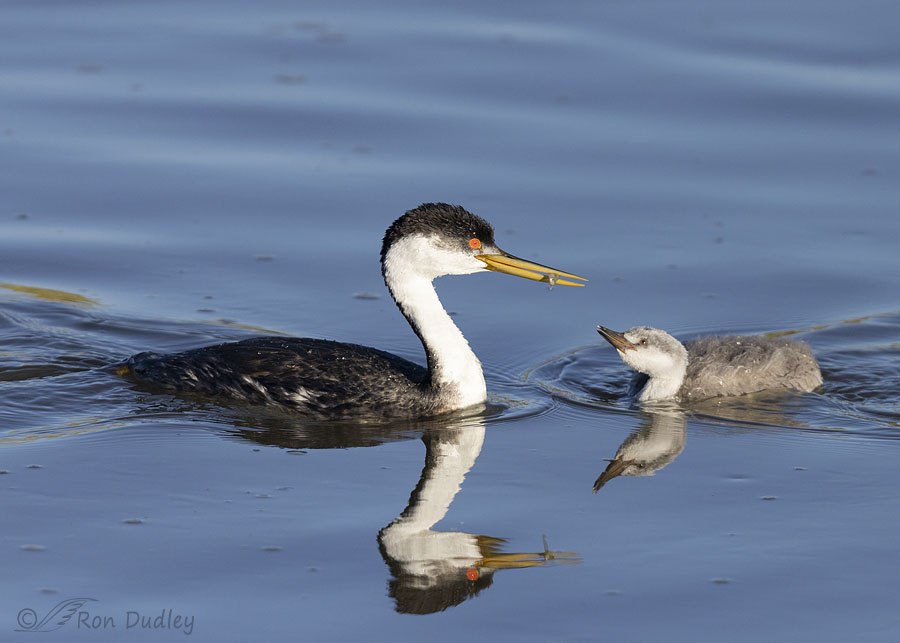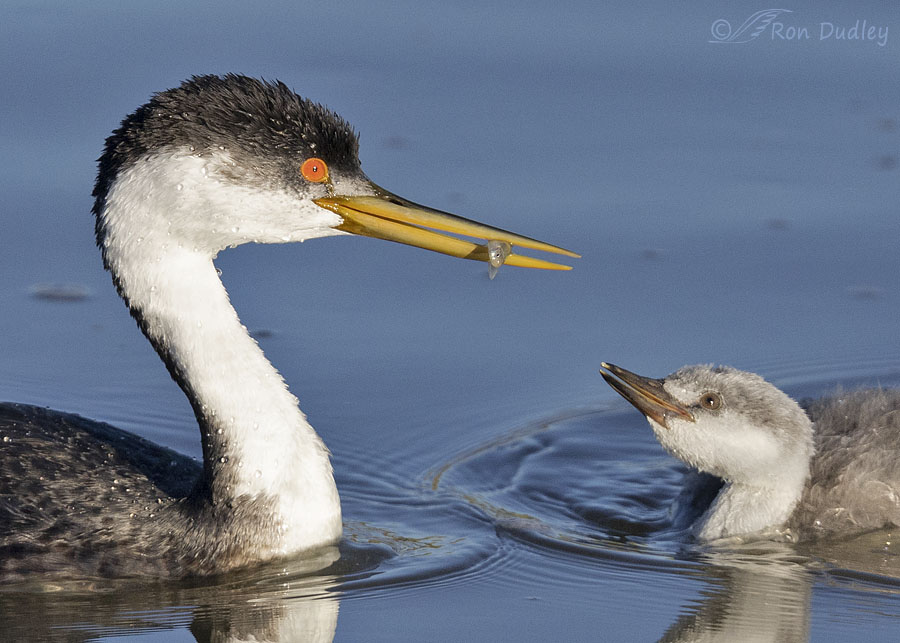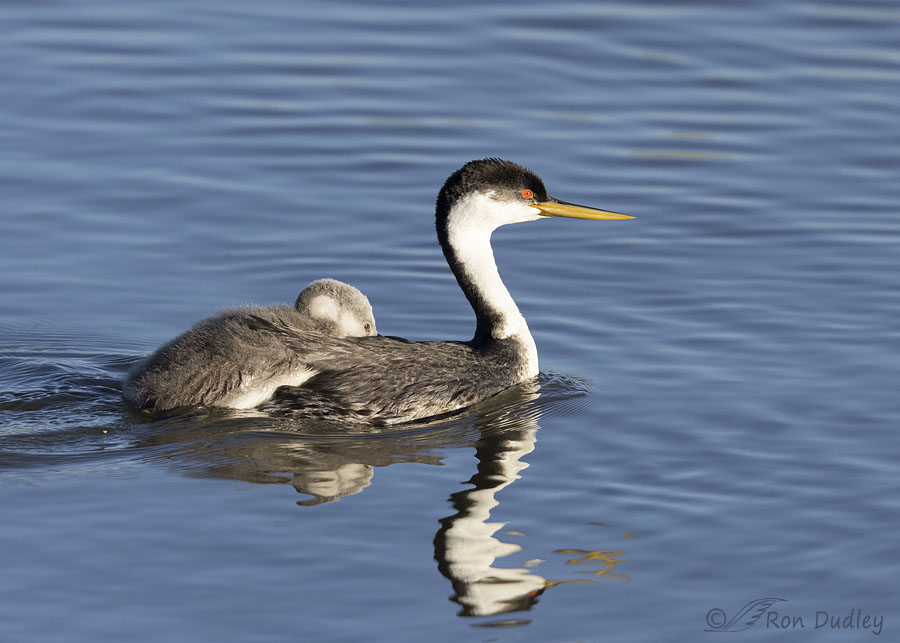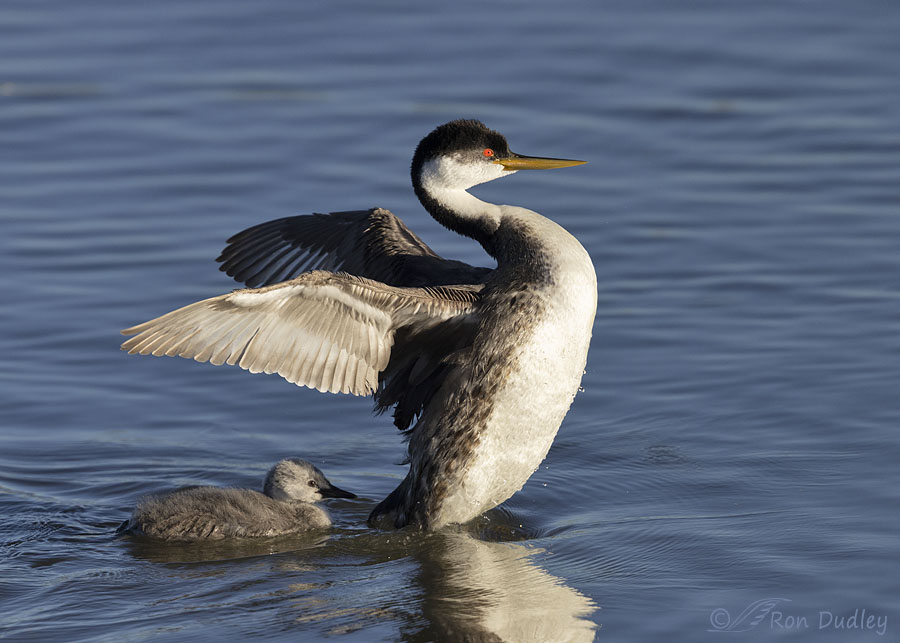Feeding chicks and a variation of “chick-dumping”.
Lots of locals have been posting photos of Western Grebes at the 4-way pond at Farmington Bay WMA. I figured I should join in the fun, even though the shooting angle there is usually a steep one.
I’m going to concentrate on their behaviors.

1/5000, f/6.3, ISO 800, Canon R5, Canon EF500mm f/4L IS II USM + 1.4 tc, not baited, set up or called in
Four days ago, this female (I believe, based on bill shape) Western Grebe was kept incredibly busy feeding very small fish to one of her two chicks. In 26 minutes I estimated that she caught and fed ≈25 tiny fish to this youngster while its sibling showed little if any interest in being fed. I can only guess that the other sibling was the most dominant of the two and had been fed before I got there.
There are huge carp in the 4-way pond but some of the fish that she caught were less than half the size of this one – so small I couldn’t see them in her bill until I cropped in tightly on my photos. Not much per “bite” but she sure didn’t have any trouble catching those slippery little wrigglers.
Even this fish is a little too small to see very much detail unless…

I crop in tightly on the same photo.
In past years one of the most commonly-caught fish in this pond has been the very distinctive Weather Loach but on this morning I didn’t see a single loach in her bill. I suspect they were all baby carp.

1/3200, f/6.3, ISO 800, Canon R5, Canon EF500mm f/4L IS II USM + 1.4 tc, not baited, set up or called in
I believe this is a different adult and slightly larger youngster – large enough that the adult obviously thought the kiddo was too damn big to be riding on her back. The youngster kept trying to climb aboard and she kept using the same strategy to prevent it from doing so.

1/4000, f/6.3, ISO 800, Canon R5, Canon EF500mm f/4L IS II USM + 1.4 tc, not baited, set up or called in
As soon as the chick was nearly on board the adult would rise vertically in the water and perform a wing flap, a very effective way to prevent the youngster from riding on the adult’s back. Both birds did the same things at least three times.
It’s actually a variation of a very well-known strategy that adult Western Grebes use to “dump” their younger and much smaller chicks back into the drink after they’re tired of carrying them on their back (back-brooding). I’ve documented this behavior with younger chicks in the past, but this is the first time I’ve documented it as a way of preventing large chicks from climbing aboard, rather than dumping smaller chicks after they’re already there.
Here’s what Cornell’s Birds of the World has to say about the behavior:
“Both parents brood, male tends to carry newly-hatched young more frequently than female. At end of brooding bout parent rises up in water and flaps wings, young fall off and move to other parent.”
Ron


Very neat photos! I have been out a couple of days and have around 4,000 shots that I kept so far. Slowly going over the keepers, it will take some time!
Feeling kind of sorry for the chick trying to hitch a ride. “Curses! Foiled again!”
The close crop of the feeding shot is really special — the chick’s expression makes the shot for me.
A parent’s life (regardless of specie) is filled with work. Yet another delightful series.
Your ‘dumping’ photos made me think of our kangaroos. Joeys climb into their mother’s pouch LONG after they are too big to do so. (I call them pouch potatoes). I am sure that the mother wishes she had such a simple and effective way to evict them.
“Pouch potatoes” – good one, EC.
I’m surprised the mother kangaroo doesn’t just prevent them from jumping in. Seems like it would be easy for them to do, but what do I know…
Wonderful shotsRon! Thanks for sharing.
Charlotte Norton
Thanks, Charlotte.
Just a slice of Grebe family life. You do manage to make it a fascinating slice.
Nice touch with the reflections in the first scene.
Thanks on both counts, Lyle.
I don’t care who one is I don’t believe one could see better shots than these! Wonderful images, and I agree I really like the close-up, picture #2.
Thanks very much, Dick.
Love the Photos and your documentation of the Grebes behaviors! Thanks once again.
Good. Thanks, Joanne.
Excellent photos and story. Really like the closeup in that 2nd photo. Dumping the kids is no different than a mom you might see in the mall saying no Johnny, you’re too big and I am no carrying you anymore. Whether birds or animals – in nature you grow up very quickly.
Thanks, Everett. I like to delude myself into thinking I still haven’t grown up…
Me too Ron – even at 84 not quite sure grown up yet
That last photo had me laughing out loud, Ron! Your Western Grebe photos are always among my favorites. Well, those and your Shorties, and Magpies, and Red-tails, and….. Thanks again for bringing a burst of joy to my morning.
Thank you, Diane.
“Chick dumping.”…..I guess that every parent has their limits ! In the first
two images, I noticed that the chick’s break is CLOSED, unlike the usual gape-mouthed begging we usually see when baby birds are being fed—the
chick looks patient and trusting–maybe that’s why it gets fed after the
dominant sibling ?
Kris, I suspect the chick’s beak was open very soon after the photo was taken. I can guarantee you that it didn’t turn the fish down!
Western Grebes are always a treat to watch in your photos! Luv the intensity of the chick in the 1st photo and then the adults method of getting rid of the chick wanting to ride!
Luv the intensity of the chick in the 1st photo and then the adults method of getting rid of the chick wanting to ride!
Little rain for us – hope CB got more! Grackles seem to have moved on – WHEW – VERY noisy bunch.
Thanks, Judy. I hope CB got rain too but I haven’t heard about it from my cousins on the farm – which doesn’t necessarily mean they didn’t get dumped on.
Very interesting. Another lesson.
Reminds me of children when they are able to walk around on their own and have become too large to carry for any length of time, but they still want you to carry them around.
Amazed at the sharpness and detail that you were able to pick up on that tiny fish. Love the glassy ripples in the water too.
“Chick dumping”! I’ve neither seen it nor heard of it before but it is such a “fun” behaviour and the comparison to needy human toddlers makes it that much better. Love the closeup with the supers sharp detail but it is the behaviours that keep me coming back every morning so eagerly. We will definitely miss you while you are “down” but your observations on behaviour have a super loyal following. Thanks for a new phrase and behaviour this morning.
Thanks, Granny Pat. Love knowing that you appreciate the behaviors as much as I do.
“Amazed at the sharpness and detail”
Michael, with the grebes the R5 did an amazing job of keeping my active focus point locked onto the adult’s eye. But later in the morning it didn’t do as good a job with the Swainson’s Hawk I photographed. I can’t figure out why.
Looks like growing up is tough for everyone.
Looks like.